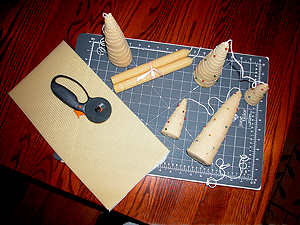 Beekeeper meetings (like bee blogs) get short on material in the winter, so our last formal agenda focused on "how to roll beeswax candles."
Beekeeper meetings (like bee blogs) get short on material in the winter, so our last formal agenda focused on "how to roll beeswax candles." Initially, I thought this would be lame. Why? Because the purist in me knew that none of us individually produce the groovy honeycombed beeswax with which we would work. It is, in fact, the same stuff we buy in order to make frames for the the insides of our beehives. I was, however, mollified (and drawn in) by learning that beekeepers actually contribute their melted wax cappings and so on to "wax accounts" at the supply houses. Therefore, while the wax at hand was unlikely to contain any one beeyard's product, it was a wonderful amalgam of pure bee handiwork from all over.
And the scent is terrific, too. As my friend Alexandra said when she got her candles, "they smell good enough to eat or roll in." They smell like the inside of a hive, actually, and you should take any possible opportunity to sniff them out sometime.
The basics of beeswax candlemaking are as follows:
- Order some beeswax from any number of bee gear purveyors – some won't ship to you in cold weather, though, because the stuff can break. I guarantee that your local craft store does not have any;
- Get honest-to-goodness candle wicking, and this is probably available locally;
- Cut the wicking to about 24 inches, enough for two tapers plus some extra;
- Take one sheet of the beeswax, and find the middle of the long side. Cut across the wax at a slant that starts about 1/4 inch short of the center line on one side, and ends 1/4 inch over the center on the other. You should end up with two pieces of the same size and shape, mostly square but with one slanted side;
- With the longest side closest to you (the side that comes to the sharpest point), place one end of the wicking along the long edge, with the pointy side on your left and the square on your right, making sure that the wick is roughly even with the square side;
- Begin to fold the edge of the wax over the wick, maybe 1/8 to 1/4 inch wide. It will look pretty uneven at first, but don't worry. Work along the whole edge;
- Once you have the length of the wicking enclosed, begin to turn that edge over and over on itself, gently but firmly. Make sure that the square end of the sheet stays even with itself. The pointy end should begin to form a pointy candle end.
- When you run out of wax, you have made your first candle! Press gently but firmly along the seam at the end, with warm fingers you should be able to work it down mostly smoothe.
- If you want to put a tag on your candle, now is the time. Thread it on the wicking which is sticking out;
- Now, starting from the other end of the wick, make the other candle, pointy end facing the pointy end of the candle you just made.
- When you finish the second candle, you can pick them both us by the wick, and tie a little ribbon around the middle to make a nice presentation.
Remember to trim any wick to 1/2 inch before lighting. Your candles may get a little white haze on them if they sit around a while. If you expose them to warmth, this will disappear.
There are lots of other candle designs around (I used a Christmas tree pattern and some straight pins with pretty heads for mine), but this is the simplest.
But a beeswax candle, like life, does tend to change as it gets older. It gets that homely crust, it don't smell as good as it used to, and it can crack and crumble at the edges. You should go ahead and use your candles, especially during the colder, darker times of the year when the bees aren't around to amaze us.
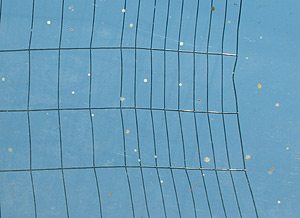 For the first time this month, temperatures on the roof rose to about 50 degrees F, and the girls took flight. It was a day of much work for them, I think, as well as a bit of a release and relief.
For the first time this month, temperatures on the roof rose to about 50 degrees F, and the girls took flight. It was a day of much work for them, I think, as well as a bit of a release and relief.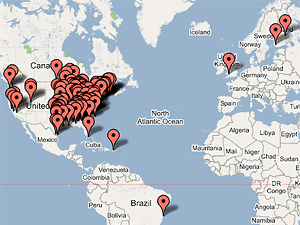
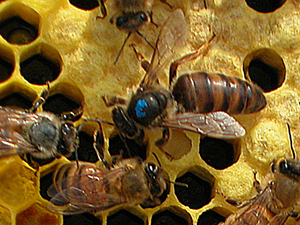 The bee at top is Elizabeth, the Queen of the Wilde colony. That sporty blue mark came from the beekeeper who bred her. If you look at her, she resembles the bees' cousin the wasp more than her workers do. Notice that her broad shoulders have no fuzz, and that her butt is way long and tapered. I think she is pretty. This picture was taken in late May.
The bee at top is Elizabeth, the Queen of the Wilde colony. That sporty blue mark came from the beekeeper who bred her. If you look at her, she resembles the bees' cousin the wasp more than her workers do. Notice that her broad shoulders have no fuzz, and that her butt is way long and tapered. I think she is pretty. This picture was taken in late May.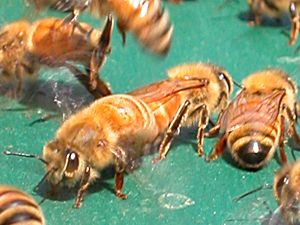 Now, here at the front left is a young worker bee, currently a house bee. After they emerge, bees spend about the first three weeks of their life doing tasks inside the hive. In this picture, it's a really hot day and the girls are fanning up a storm to try to cool the hot insides of the hive boxes. Take a look at her shoulders, where the wings attach. She is all golden and fuzzy! Most of the bees I see when opening the hives are like this: young and occupied with tasks like nursing young, drawing out honeycomb, and putting away honey stores. The girls were fanning so hard because it is still late May, and the BeeCool hive ventilators have not arrived. I think she looks like she is saying "Hurry up already with the AC!"
Now, here at the front left is a young worker bee, currently a house bee. After they emerge, bees spend about the first three weeks of their life doing tasks inside the hive. In this picture, it's a really hot day and the girls are fanning up a storm to try to cool the hot insides of the hive boxes. Take a look at her shoulders, where the wings attach. She is all golden and fuzzy! Most of the bees I see when opening the hives are like this: young and occupied with tasks like nursing young, drawing out honeycomb, and putting away honey stores. The girls were fanning so hard because it is still late May, and the BeeCool hive ventilators have not arrived. I think she looks like she is saying "Hurry up already with the AC!"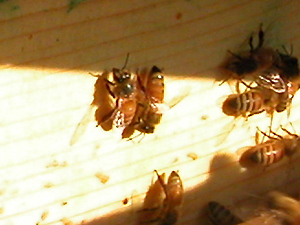 It's not easy to get a picture of an old bee: they tend to be out in the field during the day when I make my visits, and they try to die outside of the hive so no other bee has the extra work of pushing them out the front door when they pass. The bee furthest to the left has probably lived most of her life by now. Look at her shoulders: the fur has been worn off of her back, probably scraped away little by little by all of her trips in and out of the narrow hive entrance.
It's not easy to get a picture of an old bee: they tend to be out in the field during the day when I make my visits, and they try to die outside of the hive so no other bee has the extra work of pushing them out the front door when they pass. The bee furthest to the left has probably lived most of her life by now. Look at her shoulders: the fur has been worn off of her back, probably scraped away little by little by all of her trips in and out of the narrow hive entrance. 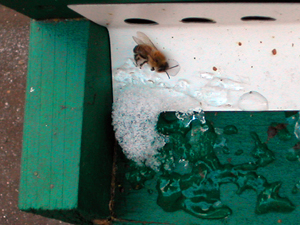 Winter is well and truly here: our first snow came last night, leaving a couple of inches and some ice. I went up to peer at the bees, not wanting to disturb them enough to cause a guard bee to detach from the inside cluster. Giving me a piece of her mind could cost her the rest of her life when the temperature is low!
Winter is well and truly here: our first snow came last night, leaving a couple of inches and some ice. I went up to peer at the bees, not wanting to disturb them enough to cause a guard bee to detach from the inside cluster. Giving me a piece of her mind could cost her the rest of her life when the temperature is low!